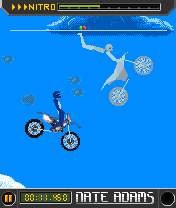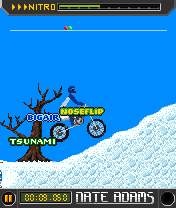There are few sports that are as awe-inspiring as freestyle motocross, where a highly skilled athlete can treat a motorcycle as a kind of aerial dance partner while gravity is temporarily held at bay. I-Play's Nate Adams Freestyle Motocross deems itself a racing game, but only in the simplest sense of the term. While finishing courses as quickly as possible is the objective, the gameplay is primarily concerned with the delicate balance of forces that emerge when motoring over rough terrain at high speeds. Truth be told, there have been many side-scrolling-racing offerings that have leaned on this time-honored mechanic, such as the classic mountain-biking portion of California Games and the mobile racer Moto Maniacs. Though Nate Adams Freestyle Motocross doesn't get the physics of freestyle motocross exactly right, it's still a worthy entry to the genre, and it's a fun game overall.
Like most other motocross games, Nate Adams keeps its gameplay as simple and intuitive as possible. There are three simple controls that are all you need to flourish in this basic Newtonian physics model: accelerate, lean forward, and lean back. All the other buttons let you perform secondary tricks during your frequent trips off the track and into midair. Basically, your bike is inherently unstable, and it only becomes more dangerously flighty as you guide it over the courses' many bumps, hills, and ramps. It takes a steady hand on the tiller to keep your rider in his seat and off the ground. As a result, you have to constantly correct the bike's balance and acceleration to ensure that you don't over-rotate on a jump or collapse backward while riding up an incline.
To advance through the game to unlock more of its 20 or so tracks, you need to satisfy certain goals on each level, which consist of some combinations of time limits and certain required tricks. For example, you might need to pull off a backflip, a wheelie, and a "big air" (pulling three seconds of air off a jump) during your run, as well as finish the course within 40 seconds. Every trick you successfully complete fills up your nitro meter a bit, boosting your speed and prompting flames to shoot from your tailpipe. Nitro is a fickle force indeed, because the momentum it provides can help you get more air off jumps, and you can finish courses faster with it. However, you'll need to be that much more careful with your balance whenever it's involved in gameplay. Crashing your motorcycle isn't the end of the world, either. You'll quickly get back on your bike, losing any nitro or in-progress trick points you may have earned in the process, in addition to losing precious time and velocity.
Games like Nate Adams Freestyle Motocross live and die by the overall feel of the physics model. Do the mechanical forces in play feel realistic, consistent, and manageable? The answer here is yes, for the most part. There's a definite learning curve associated with divining the right timing and lean for every situation, which depends on your speed, the angle of the terrain, and other factors. Happily, this learning process is part of the fun, because the game brings you along slowly. Each new track will present more-complex terrain and new required tricks, and it'll probably take you several tries to advance to the next one. The tricks, for their part, are both varied and interesting. They look cool and also profoundly influence your balance. As a result, a no-hands maneuver will cause you to lean forward rapidly, while a "lazy boy" will straighten you out and rotate you mildly backwards. On the flip side of the coin, there are a few sticking points in the physics model. The most notable one is your cycle's backward-leaning bias. This is a common feature in such games, but it's overpronounced in Nate Adams. So if you start out with no velocity when going up a hill, for instance, you'll probably flip over backwards when you try to accelerate. This means you'll need to roll back down the hill to try again. Your bike's default engine also feels a little on the underpowered side, and this exacerbates the problem. After playing for a while, though, you'll factor these difficulties instinctually into your control. However, the bike mechanics could definitely have benefited from more tweaking.

From a visual angle, Nate Adams Freestyle Motocross gets the point across, and not much else. The bike and rider models make use of so-called "rag-doll physics" in their behaviors, and thereby offer up a very realistic-looking rendering of motocross riding postures. There's not much other visual detail to speak of in the Motorola V600 version of the game. Even though the environmental backdrops are fairly unadorned, the frame rate still chunks up every so often on this midrange handset, and the loading times can be a pain. This problem is particularly pronounced during "shadow races" against one of your previous runs, when a spectral outline of another racer appears onscreen. Nate Adams also makes use of some simple sound effects to indicate the race countdown, successful tricks, and so forth. Additionally, there's an interesting, pounding MIDI tune for the title screen.
This game probably won't knock California Games out of its place of honor in your childhood memories, but it's pretty successful at capturing the precise teeter-totter action that makes motocross games so much fun, and it's probably one of the best versions you'll find for your phone. Nate Adams Freestyle Motocross' lack of online track downloads and shadow races is disappointing, but there are still enough preloaded tracks to keep most players busy for a good, long while.
